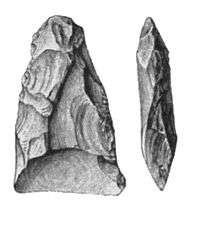Fosna–Hensbacka culture
| The Mesolithic The Epipaleolithic |
|---|
| ↑ Paleolithic |
| ↓ Neolithic ↓ Stone Age |

The Fosna/Hensbacka (c. 8300 BCE – 7300 BCE, or 12000 cal BP – 10500 cal BP), were two very similar Late Palaeolithic/early Mesolithic cultures in Scandinavia, and are often subsumed under the name Fosna–Hensbacka culture. This complex includes the Komsa culture that, notwithstanding different types of tools, is also considered to be a part of the Fosna culture group.[1] The main difference is that the Fosna/Komsa culture was distributed along the coast of Northern Norway, whereas the Hensbacka culture had a more eastern distribution along the coast of western Sweden; primarily in central Bohuslän to the north of Gothenburg. The Hensbacka culture evolved into the later Sandarna culture which is found along the coast of western Sweden.[2]
Recent investigations indicate that this particular area, i.e. central Bohuslän, may well have had the largest seasonal population in northern Europe during the Late Palaeolithic/early Mesolithic transition. This was due to environmental circumstances brought about by the relationship between the Vänern basin in the east, and topographical features in the North Sea basin to the west. [3][4]
Fosna–Hensbacka culture group
The name Fosna takes its name of a location in Kristiansund, and it is an umbrella term for the oldest settlements along the Norwegian coast, from Hordaland to Nordland. The oldest settlements in Bohuslän on the Swedish west coast (the Hensbacka), derive from the Ahrensburgian culture group from Northern Germany. The oldest Fosna settlements in Eastern Norway are found at Høgnipen in Østfold. New finds (2008) on Pauler in Larvik seem to be even older.[5]

The settlements were located close to the contemporary seashore but, due to constant land uplift after deglaciation, they are now 60–70 m above present-day sea level in western Norway, while Høgnipen is as high as 150 m above present-day sea level, the difference being due to the greater crustal rebound on the Baltic side of the Scandinavian peninsula. Site locations indicate that fishing and seal hunting were important for the economy and it is assumed that hide covered wooden framed boats were used in that the majority of Hensbacka sites (ca.75%) are located on islands in the outer archipelago. The Fosna/Hensbacka culture represent a pure hunter-gatherer culture. On settlements, archaeologists have only found stone tools and the remains of the production of the same. Characteristic tools include flake axes, lanceolates and tanged arrowheads.
See also
References
- ↑ "Norway". Britannica online.
- ↑ Dr. Vincent H. Malmström. Professor Emeritus of Geography. "Norway Before the Vikings" (PDF). Dartmouth College. Retrieved August 15, 2016.
- ↑ Chronological insights, cultural change, and resource exploitation on the west coast of Sweden during the Late Palaeolithic/early Mesolithic transition. Oxford Journal of Archaeology, Vol.28 No.1, 2009. Schmitt, L. et al.
- ↑ "Why they came"; the colonization of the coast of western Sweden and its environmental context at the end of the last glaciation. Oxford Journal of Archaeology, Vol.25 No.1, 2006. Schmitt, L. et al.
- ↑ Frans-Arne Stylegar. "Fosnakomplekset". Store norske leksikon. Retrieved August 15, 2016.
Further reading
- For Hensbacka, see Oxford Journal of Archaeology, Vol.18 No.4, 1999 & Vol.13 No.3, 1994.
External links
- The Swedish National Historic Museum on the Hensbacka culture
- The Swedish National Historic Museum on the Fosna culture
- Images of Hensbacka tools
- Images of Hensbacka tools 2